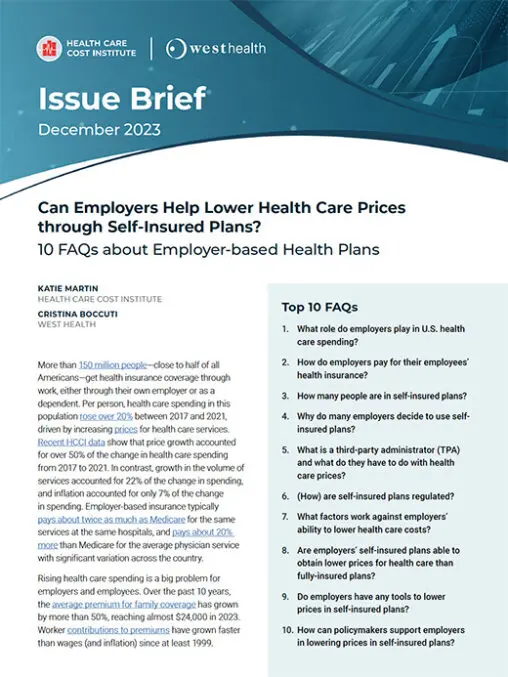FAQ – Employer-Based Health Plans
More than 150 million people—close to half of all Americans—get health insurance coverage through work, either through their own employer or as a dependent. Per person, health care spending in this population rose over 20% between 2017 and 2021, driven by increasing prices for health care services. Recent HCCI data show that price growth accounted for over 50% of the change in health care spending from 2017 to 2021. In contrast, growth in the volume of services accounted for 22% of the change in spending, and inflation accounted for only 7% of the change in spending. Employer-based insurance typically pays about twice as much as Medicare for the same services at the same hospitals, and pays about 20% more than Medicare for the average physician service with significant variation across the country.
Rising health care spending is a big problem for employers and employees. Over the past 10 years, the average premium for family coverage has grown by more than 50%, reaching almost $24,000 in 2023. Worker contributions to premiums have grown faster than wages (and inflation) since at least 1999.
In addition to rising costs paid through premiums, Americans are paying more in cost-sharing for services and deductibles when they seek care. Recent survey data suggest that that over 40% of individuals and households do not have the necessary liquid assets to cover the typical deductible in an employer-sponsored health plan. As employers pay more for health care, this might lead to lower wages and/or less generous coverage, including higher employee premium contributions.
Below we answer 10 basic questions about the role of employers in lowering health care spending.
Top 10 FAQs
- What role do employers play in U.S. health care spending?
- How do employers pay for their employees’ health insurance?
- How many people are in self-insured plans?
- Why do many employers decide to use selfinsured plans?
- What is a third-party administrator (TPA) and what do they have to do with health care prices?
- (How) are self-insured plans regulated?
- What factors work against employers’ ability to lower health care costs?
- Are employers’ self-insured plans able to obtain lower prices for health care than fully-insured plans?
- Do employers have any tools to lower prices in self-insured plans?
- How can policymakers support employers


